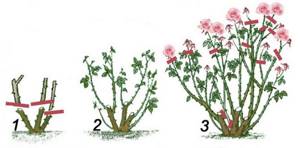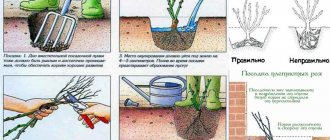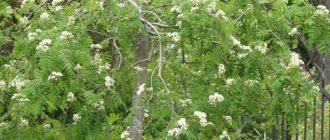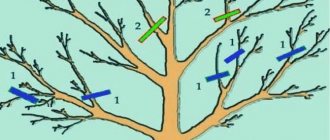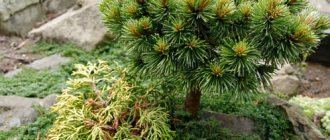Types of rose pruning
There are many ways to prune plants. Depending on the time of year and type of crop, different methods can be used.
Sanitary pruning involves removing diseased, dried out, frozen, twisted and weak branches
- Short or maximum pruning , suitable for processing plants before winter or spring, when planting. Used for bush roses such as floribunda or tea, polyanthus varieties. During this procedure, only 1/3 of the branches are left, and the pagons are cut so that no more than 4 buds remain on the stem.
- The medium or moderate procedure is suitable for any medium-sized roses, regardless of type. It is carried out after the plants flower. The pagons are removed 6 eyes from the ground. So a neat, lush bush is formed.
- Minimal or light pruning is done for climbing plants and hybrid teas that have tall sills. In this case, it is typical to shorten the pagons by 8-15 eyes from the root part of the bush. It is carried out in the spring, when planting bushes.
- Combined pruning is characterized by shortening the pagons at different levels. Suitable for bush roses. It is also carried out for park roses of various types in order to obtain one form or another of the plant.
- Sanitary pruning is the basis. It is needed throughout the year. Involves removing diseased, dried out, frozen, twisted and weak branches. They are always cut down to healthy tissue and burned.
Important!
To trim roses, use only sharp pruning shears. It must also be treated with a disinfectant. This is done so that when cutting branches, harmful bacteria or fungal spores do not enter the plant through the tool.
As you can see, there are many ways to prune this crop. When choosing a method, you need to rely on the type of plant, season and goals.
Should roses be cut in summer?
On a note! Roses are usually pruned in autumn or spring. However, this procedure can also be carried out in the summer.
Caring for petunia during flowering
During this period, its main goal is the need for roses to bloom again after a certain period of time. First of all, this applies to large-flowered and standard varieties. It should be noted that there are varieties of roses that can bloom only once per season, and pruning cannot change this property. This category includes, for example, individual climbing roses, the buds of which form on last year’s shoots. However, there are very few such varieties, and most of the most common varieties (Floribunda, David Austin, etc.) do not belong to them. In order for the plants to bloom again, it is necessary to cut the stems low, which will accelerate the rapid formation of new shoots. For those roses that bloom once per season, only the flowers are removed.
In some cases, there is a lack of flowering of plants under normal cultivation conditions. The reason for this is the so-called. blind escape. At the top of such stems there are scars of a darkish color or an underdeveloped bud, whereas in full-fledged shoots the top is crowned with this year's growth or bud. Such a defect in the spring can be triggered by late frosts, and in the summer it can be affected by metabolic disorders or fungal diseases. To get rid of this defect, you should remove the apical bud, capturing part of the normal stem with a leaf.
Important! In summer, plants are often affected by fungal diseases. This is usually observed in case of gross violations of cultivation technology: excess moisture, thickened plantings, excess dosage of nitrogen fertilizers, etc.
With regular visual examination, it is possible to quickly determine the initial symptoms of ailments and carry out the necessary treatment. At this stage, it is very effective to remove affected areas of plants while capturing a small part of healthy plant tissue. If this procedure is not carried out, the disease will spread further and destroy the plant unless chemical remedies are used.
Perennial plantings require regular anti-aging pruning. First of all, this need manifests itself in bush roses. Usually this pruning is carried out in the autumn, but this time of year is usually characterized by wet weather. In view of this, open stem sections become accessible to various infectious diseases. When pruning in summer, the cuts dry out relatively quickly. The procedure is carried out shortly after flowering has completed, in dry weather. Thickened stems located in the lower part of the plant and characterized by dark-colored bark are removed.
Important! Shoots are removed either completely, at ground level, or they are transferred to the nearest strong lateral shoot.
Summer pruning is especially important for established plants. Such roses often begin to grow multiple shoots below the grafting site. This process is especially strong and poorly controlled after severe cold winters. If this new growth is not removed in time, it can absorb all the nutrients, resulting in the death of the varietal rose.
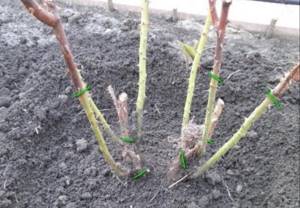
Should roses be cut in summer?
A situation often occurs when varietal plants freeze out in cold winters, and in the spring shoots begin to grow from the roots. Before pruning it, you should make sure that it is a real growth from a wild species, and not from a variety. In cultivated roses, the leaf usually consists of 5 leaves, and in wild roses - from 7. However, some varieties also have 7 leaves, so you need to pay attention to the color of the foliage. In wild plants, the leaves are pale, unfulfilled and smallish; they lack the glossy sheen characteristic of varietal plants. Wild animals also do not have a reddish coating on the leaves and young stems of the bush.
Note! Unlike most roses, ground cover roses do not require heavy pruning. In the first year, they make do with light pruning of the stems, and then they carry out only sanitary pruning.
Garden pruning tools
Also check out these articles
- African swine fever
- Strawberry variety Ruyana
- How to hatch goslings in an incubator
- Pig litter with bacteria
To avoid any difficulties during the procedure of pruning roses, you need to make sure that you have all the necessary tools in advance. But what might you actually need:
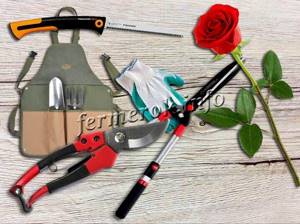
Photo of garden tools for pruning roses
- Secateurs with 2 cutting blades . It is used for cutting dry twigs.
- Secateurs with 1 cutting blade . Used for trimming thick and woody branches.
- Garden scissors with long handles . They are necessary if you need to remove branches from inside the bush. Without this tool, there is a high chance of getting a lot of scratches on the thorns.
- Garden saw . It will be required if you have to cut down branches with a diameter of 20 mm or more.
- Gloves – protect hands. It’s better to take thick rubber ones.
- Garden apron to protect clothes and body from plant thorns.
- Disinfectant composition . This could be a solution of potassium permanganate, chemicals like Topaz and others. The products dilute and treat instruments during operation so that bacteria and fungal spores are not transferred through them.
After preparing all the necessary tools, you can begin the procedure itself.
Pruning roses in spring
Spring pruning is essential. At this time, the plant is vulnerable, it awakens from winter and requires special care. Timely pruning in the spring allows you to provoke the development of new pagons, improve the condition of the root system, and slow down the development of diseases, if any.
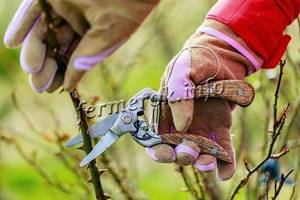
Pruning roses in spring
Important!
Rose branches are cut at an angle of 45 degrees, moving upward from the bud by 5 mm.
In spring, pruning of roses is carried out only after warm weather sets in. The buds may already be swelling, but the branches themselves should not be growing yet. Before the procedure, the culture needs to be prepared. First, they remove the winter shelter (if there was one), then clean off any debris that may have accumulated under the plant, old leaves, or fallen branches. If there is mulch, it must be removed. After this, the pruning itself is carried out.
If the bush is thickened, you can remove all the pagons except the 5 strongest, healthy ones. In the spring, pruning is necessary for all types of roses, because during the winter some branches could freeze, and sometimes it happens that pests and diseases damage the pagons in winter. This is visible during spring pruning, and all bad branches can be removed in a timely manner to keep the plant healthy.
Summer pruning of roses
We recommend reading our other articles
- Cranberry jam
- Rabbit breeding
- Varieties of cucumbers for greenhouses
- Keeping ducks at home
Several prunings are required in the summer. To begin with, they continue to do sanitary and formative pruning according to needs. All dry, wilted branches, diseased or damaged branches are cut to the top leaf.
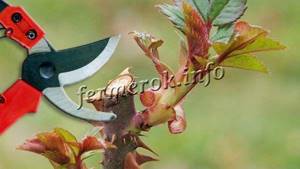
Summer pruning of roses
Interesting!
Roses older than 3 years can produce many new shoots in late summer. If they are not removed, the bush will become thickened. Such plants consume too much water and nutrients. And if they are missing, the rose will not produce flowers.
Also in summer, pruning is done after flowering. By cutting off faded inflorescences, you can prolong flowering and improve the condition of crops. Pruning is done with pruning shears.
- From a bush rose, you need to remove not only the runner with the flower, but the entire brush on which the flowers form, right above the top leaf.
- If 1 flower is formed on a branch, then the shoot is cut so that it has only 3-4 leaves above ground level. Thanks to this, new branches will form from the root.
- If the rose is climbing, remove the tassels down to the first leaf. Thanks to this, branching of the pagons occurs, on which new flowers will then appear.
As you can see, pruning roses in the summer and after flowering can require a lot of time and effort, but only in this case can abundant budding be achieved.
The machinations of the aristocracy
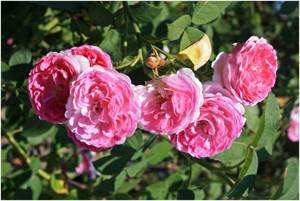
The photo shows a garden rose, President de Seze variety
On the eve of getting acquainted with pruning garden roses, it makes a lot of sense to think about the reasons that force you to take such a bold “surgical” step, despite the prickliness of the heroine of the topic:
- Firstly, the rose is a long-liver (5-35 years), which by default gives its bush regeneration due to the growth of young shoots from the buds formed on adult trunks, as well as the mother basal cone. If young shoots do not give way to old ones in a timely manner, the “aristocrat” will grow wild within two to three years, and may even stop blooming. At the same time, young shoots can prevent old shoots from blooming, taking energy for themselves. Accordingly, cutting off excess tops helps control the size, shape and flowering of the rose;
- Secondly, the garden queen shrub is replete with dozens of shoots. Not all of them can withstand climatic loads: often individual trunks are damaged, become sick, and weaken. Damaged areas serve as a hotbed for the spread of diseases throughout the bush, which is why they need to be cut off;
- Thirdly, the rose welcomes propagation by cuttings. This makes summer pruning of roses relevant, in which the cut trunks are preserved as planting material, provided that they are healthy.
- Fourthly, the rose, being a perennial flower, must overwinter. The middle zone and Trans-Urals can easily kill a lovely flower with their fierce winters. But if the rose is properly pruned and prepared, it will not be afraid of any jelly.
Proper pruning of roses in autumn
In autumn, sanitary pruning is just as important as in spring and summer. Moreover, this is the time for the development of fungal diseases. In general, bushes should be inspected once every 1-2 weeks and, if necessary, cut off affected, crooked, and extra branches.
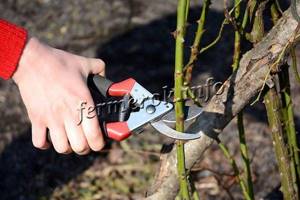
Proper pruning of roses in autumn
Important!
You cannot cure a bush by pruning. This procedure only slows down the development of the disease. Therefore, if the bush is sick, after pruning it is necessary to treat it with fungicides.
Also, winter pruning may be required in the fall. This is done exclusively for those plants that grow in the middle and northern regions of Russia, where it is quite cold in winter and therefore requires shelter for the winter. Before insulating the bush until spring, it is pruned. Pruning is usually done to the height of the shelter, so it can be maximum or minimum - determined by the shelter. If flowers grow in warm countries and are not covered, you can do without this procedure.
How to prune a rose correctly
With high-quality pruning, minimal damage is caused to the bush. All its cuts will quickly heal, young branches will begin to grow quickly, and budding will be maximum. But how to prune roses correctly:
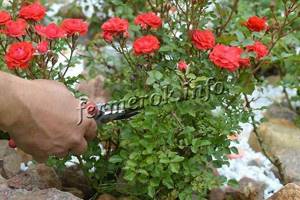
How to prune park and home roses correctly
- For park roses and home roses , the branches are always cut at an angle of 45 degrees and 5 mm above the eye.
- For a bush rose, the procedure can be done in different ways. For example, in order for a lush, wide bush to grow, the pagons are cut above the bud that grows from the outside. Then the young pagon will appear from the outside, and not from the inside. If the goal is a straight bush with straight shoots, pruning is done to the bud, which is located on the inside of the bush.
- Branches of one-year-old seedlings are cut off by approximately 1/2. This is done so that the culture can devote energy to the development of the root, and not the lush above-ground part.
- From the 2nd year, 2-3 restoration branches will appear on the bush. It is on them that flowers appear, so these pagons cannot be cut to the ground! They are only shortened by 2-3 buds.
- From the age of 3, the bush is considered an adult. Its pruning is carried out in such a way that a beautiful bush is obtained. And don’t forget that it’s the sanitary treatment that gives the bush its neatness!
Interesting!
In order for the bush to form large flowers, it is necessary to cut off all the branches that grow inside the bush.
Are the buds on the roses swollen? It's time to trim!
Correct cut
The buds on the roses have begun to grow - let's start spring pruning.
This procedure will make the bushes more powerful, healthier, give them a beautiful shape, and the flowers will be larger and pleasing to the eye longer.
Writes the author of the book “Perfect Roses in One Season,” President of the Central Society of Rose Growers Lyudmila Ivanova. Before you start pruning, thoroughly disinfect the pruning shears, small saw, garden shears and knife.
The shoots should be cut at an angle of 45° downwards towards the main shoot towards the outer bud if the bush is upright. On the inside - if the bush is spreading.
The cut is made at a distance of 0.5 - 0.8 cm from the kidney. If it is higher, the wood will begin to die, and diseases and pests will multiply. An even, smooth cut should be treated with garden varnish.
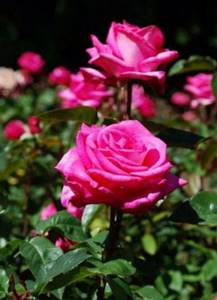
Good pruning will make the bush strong and the flower large.
Photo: PHOTOXPRESS
There are three types of pruning: with strong (short) pruning, all weak shoots are removed, and on strong ones, 2-3 buds are left.
As a result, 3–4 shoots up to 12–20 cm high remain on the bush.
With moderate pruning, 5 or more shoots 30–40 cm high with 5–7 buds are left on the bush. The bush looks more powerful, but the flowers will be of medium size.
With light pruning, only the upper parts of the shoots are removed, leaving 8 to 12 buds.
All three types can be used.
In this case, we are talking mainly about modern bush roses (hybrid tea, floribunda, grandiflora groups).
Preventative pruning is carried out when the plant has not yet begun to grow.
In addition, weak, deformed shoots and those that grow towards the center of the bush are removed. If two shoots intersect, one stronger one is left.
Then they move on to thinning pruning.
How to feed
As soon as you finish trimming the bushes, you immediately need to feed them.
The soil is quite moist at this time, so fertilizers are applied dry.
Nitrogen mineral fertilizers are used as the first fertilizing - best ammonium nitrate in the amount of 30 - 40 g per 1 square meter.
Fertilizer must be scattered around the bush at a distance of 10 - 15 cm from the root collar, and then dug up.
It is better to combine organic and mineral fertilizers; taken together, they are more effective.
The ideal organic fertilizer for feeding roses is albumin (dried bovine blood); it is mixed with mineral fertilizers in a ratio of 50x50.
In the future, fertilizers can be applied both in dry and liquid form. But keep in mind: when applying fertilizer in liquid form, they begin to act after 5 - 7 days, when applied in dry form - much later.
About the compatibility of peppers, tomatoes and cucumbers
— Is it possible to plant peppers, tomatoes and cucumbers in one greenhouse?
Igor, Shatura.
Agronomist Anatoly Osikhov answers the question:
Anatoly Osikhov.
— Peppers and tomatoes grow quite well together, because both belong to the group of nightshade crops. You can also combine them with eggplants.
They grow well together and produce a decent harvest. So, if you don’t have a separate greenhouse for each crop, plant it boldly.
But tomatoes cannot coexist with cucumbers, since they require completely different conditions. Tomatoes are supporters of drier air, while cucumbers need more humidity and higher temperatures.
Gardener's lunar calendar from May 3 to May 9
Photo: PHOTOXPRESS
May 3 - 4, Moon in Libra Neutral period for sowing vegetable and flower crops, planting bushes, transplanting seedlings.
May 5, Moon in Scorpio Watering. Sowing herbs. Planting potatoes. Clematis cuttings. Planting seedlings of tomato, cabbage, pepper, eggplant, zucchini, pumpkin, vegetable seedlings in open ground. A good time to plant mushrooms.
May 6, Moon in Scorpio Do not plant or sow anything. Grafting, pinching and pruning of plants are undesirable.
May 7 - 8, Moon in Sagittarius Planting potatoes, garlic, apple trees, oak, maple. Weed, loosen and hill well. You can thin out the seedlings. Sow fragrant and spicy plants.
May 9, Moon in Capricorn Planting bulbous flowers and tuberous plants. You can sow radishes, radishes, turnips, rutabaga, and beets. It is better not to plant flowers during this period (except for dahlias).
Pruning different types of roses
Pruning garden and park roses may differ slightly. You need to take this into account and always pay attention to this procedure.

Hybrid tea rose bushes are usually shaped like a ball.
- Hybrid tea rose bushes are usually shaped like a ball. Their flowers appear on this year's shoots, so they are shortened quite a lot (short pruning). On young plants it is enough to leave 3 buds, on adults – 5 buds, at a distance of 15-20 cm from the ground. Side branches are cut to 4 eyes.
- Floribunda roses require short pruning. If you don’t do this, the pagons will be weak and the flowers will be small. But to simplify the procedure, it is necessary to shorten some shoots completely (early flowers will appear from them), and annual and basal shoots by 1/3 of the length. Up to 3 eyes are left on young branches, and 4 eyes on old branches. The stems that grow inside the bush are cut off.
- Minimal pruning of climbing roses is done in the fall. Then the stems are tied, bent and covered for the winter, if necessary. The main pruning is done in the spring. At this time, you need to shorten the branches to get a beautiful plant shape. You can leave about 3 buds on the side pagons.
- Polyanthus roses are treated in the spring. The most developed shoots are cut by 1/3, all frozen and damaged ones are generally removed to healthy tissue. Curved branches are removed from the center of the bush. In autumn, only sanitary pruning is needed.
- Creeping roses are extensively cultivated in the fall. At this time, preventative pruning is done, and the side strips are also removed by 2-3 eyes. Only strong, basal branches are left. In spring and summer, pruning is carried out for sanitary purposes and after flowering.
If the bush is pruned incorrectly, the branches may begin to hurt. The bush will slowly recover, and its resistance to disease will decrease. Flowering may not be observed at all. That is why novice gardeners should first learn to carry out high (minimal) pruning. It practically does not harm the bush, but it brings benefits. If pruning was done correctly, the plant will develop at the same pace or even better, and will delight you with abundant flowering.
How to prune young bushes
Don't be afraid to cut. This is not as difficult as it seems, and even a half-pruned rose will look better than a bush left without any adjustments. Without hesitation, you should immediately remove frozen (black), dried (gray-brown), broken and diseased shoots.
It is imperative to prune young bushes (up to 3 years old), which have not yet matured and are just acclimatizing to the garden. All shoots are trimmed (regardless of the variety) at a height of 10-15 cm from the ground. Here, use the “palm width” rule to avoid carrying a ruler with you.
Many new gardeners make the determined decision not to cut their roses that low because... it's a shame. If the recommendations of experts are not an argument, conduct an experiment. Trim some bushes low and leave the rest to your liking. In a couple of weeks you will see a difference - many new shoots will appear on the pruned bushes, the roses will thicken and strengthen, and this is the whole point of pruning young plants. It stimulates growth. This is a biological feature - at the base of the shoots there are dozens of so-called sleeping eyes, which can only be awakened by cutting off the top (low!).
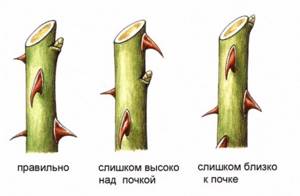
You've probably often seen roses in gardens with 1-3 hairless shoots and a few leaves at the top - this is the result of lack of pruning. Because the gardener felt a pity to cut off such a beautiful, long shoot. Unpruned plants look very unsightly, the buds appear at the bottom of the stem, as it has leaves at the top. Also, do not expect such a rose bush to produce new shoots. Therefore, we cut them, especially young roses, without hesitation, and help them bloom beautifully.
Much depends on the vigor of the variety, but you need to prune as much as necessary. Until they grow satisfactorily.
Potted plants with one shoot purchased from nurseries must be trimmed to a height of 1-2 cm!
